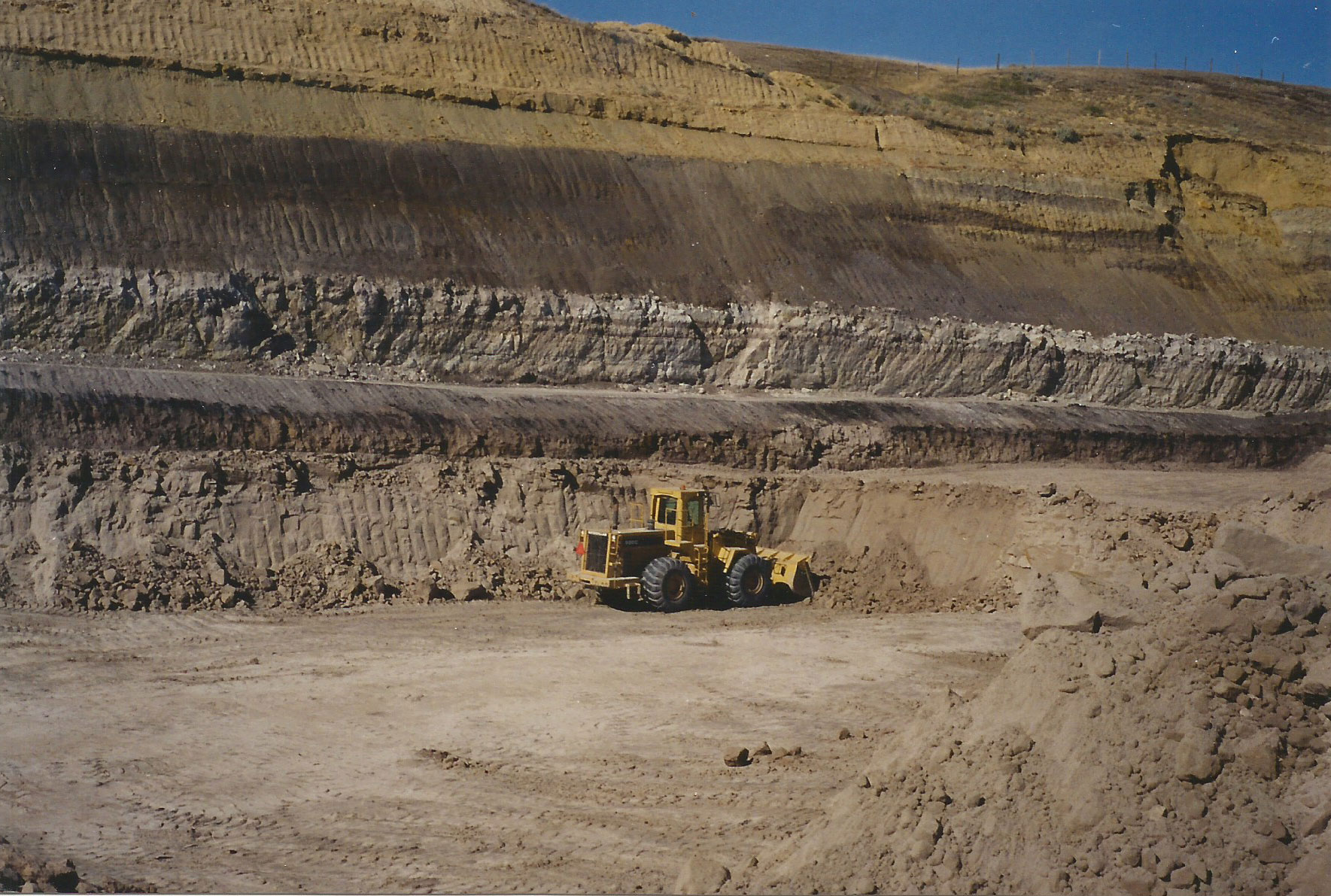| Monthly Tech-Tip | No tracking! No ads! | |
3D Clay
Alternate Names: Plainsman PR#3 D
Description: Silty tan burning, low plasticty, vitreous stoneware
| Oxide | Analysis | Formula | Tolerance |
|---|---|---|---|
| BaO | 0.40% | 0.02 | |
| CaO | 0.20% | 0.02 | |
| K2O | 2.60% | 0.17 | |
| MgO | 0.50% | 0.08 | |
| Na2O | 0.10% | 0.01 | |
| TiO2 | 0.60% | 0.05 | |
| Al2O3 | 16.30% | 1.00 | |
| SiO2 | 71.50% | 7.44 | |
| Fe2O3 | 1.10% | 0.04 | |
| LOI | 6.60% | n/a | |
| Oxide Weight | 583.84 | ||
| Formula Weight | 625.10 | ||
Notes
3D (or PR3D) is the bottom layer mined at the Ravenscrag, SK quarry of Plainsman Clays. Its combination of low soluble salts, low levels of particulate impurities, consistency and low plasticity all make it an ideal base for Ravenscrag Slip (in which it is the major ingredient). Medium temperature bodies can be made by just adding ball clay. It is silty and has traditionally been used to cut plasticity in bodies. It is the thickest layer, we have so much of it stockpiled that it is not extracted in some minings. This comes out of the ground very pure, as a silty material that weathers and breaks down readily. It is easy to process. It can readily be slurried by simply mixing the lumps into water, they slake quickly.
Because 3D already contains natural feldspar and quartz, it is a complete material, ready-to-go for many applications. The amount of processing is the primary determinant of what it is suitable for. Industrial porcelains and stonewares for traditional ceramics (e.g. tile, brick, pottery) are made mainly from feldspar, quartz and kaolin/ball clay; each of these are available from many suppliers in many grades (according to the amount of processing). These industrial minerals are selected for their physical properties (e.g. plasticity, behaviour in slurries, powder flow properties, particle size distribution) and their fired properties (e.g. whiteness, shrinkage, density, vitrification influence, chemistry). Bodies made are often less-than-optimal because of material price considerations. And sub-optimal working properties often must be tolerated to achieve a specific fire properties goal. Plainsman 3D was formulated by Mother Nature. Without any additions, it already has most of what is needed for making ceramic tile, for example. Specific industrial minerals can be added in minor amounts for specific effect (e.g. 2% talc to make it mature 2 cones lower).
We are making large ceramic test tiles from pure 3D. It dries quickly, fits glazes well, and fires strong. By itself, its silty nature makes it unsuitable for a plastic body (e.g. for throwing). But it does have plenty of plasticity for pressing, extruding or rolling ceramic tiles. And it dries quickly with minimal shrinkage.
Related Information
Plainsman PR#3D Stoneware fired bars

This picture has its own page with more detail, click here to see it.
These PR3D bars are made for the SHAB test. The top one is cone 10 Reduction. Below that, cone 10 down to 5. The clay has been ground to 42 mesh, that standard size at Plainsman Clays. Notice that in reduction firing (top bar) there are almost no iron specks! And it has fired dense, to a porosity below 0.5%. At cone 10 oxidation the porosity is 0.8%. Drying shrinkage is between 5 and 5.5%. Fired shrinkage at cone 10 is less than 7%. At cone 7 it is a stoneware, having only 6% firing shrinkage and 3% porosity. This data is amazing because it is an unprocessed clay, merely ground in a hammermill to break up the lumps.
Mother Nature's porcelain and stoneware

This picture has its own page with more detail, click here to see it.
These are Plainsman PR3B and PR3D. The 3B bars are fired from cone 8 down to 2 (top to bottom) and the 3D ones from cone 9 down to 3. The 3B has added Nepheline to achieve zero porosity below cone 4 (to make an even better MNP). When plus 325 mesh particles are removed from the 3D is becomes quite plastic, suitable as a stoneware by itself (which we call MNS). And it reaches zero porosity around cone 6. 3D is lighter burning and cleaner, 3B is more vitreous and plastic.
Mother Nature's stoneware and glazes!

This picture has its own page with more detail, click here to see it.
To make these cone 6 mugs, I slake and slurry up raw lump Plainsman MNS clay and process it through a 325 mesh vibrating sieve (MNS is actually PR3D). This natural porcelain vitrifies to zero porosity at cone 6, yielding incredibly strong ware. I also make these outside and inside glazes, GA6-C and GA6-B, from this same clay plus ones we mine in Montana and Alberta. Using glaze chemistry, I can maximize the clay percentage to more than 70% of the recipe (for firing at 2200F). Of all the pieces I make, ones like these mean the most to me.
Mel Noble at Plainsman Clay's Ravenscrag, Saskatchewan quarry

This picture has its own page with more detail, click here to see it.
Six different sedimentary clays are extracted from this quarry. It was opened in the 1970s, the best location available at the time. These test bars were made by slaking select lumps from each layer (thus exhibiting their best performance). The left-most dried test bars show the layers (top to bottom). The A1 top layer is the most plastic and has the most iron contamination (it is used in our most speckled reduction firing bodies). A2, the second one down, is a ball clay (similar to commercial products, although darker burning), it is very refractory and the base for Plainsman Fireclay. A3, third from top, is a complete buff high-temperature stoneware (like H550), although sandy and over-mature at cone 10. 3B, third from bottom, is a smooth medium-temperature stoneware; it contains significant natural feldspar (although fired color and particulate contamination are the most variable). The second from the bottom, 3C. fires the whitest and is the most refractory (it is the base for H441G). The bottom one, 3D, the best product in the quarry. Although the least plastic and most silty, it is also very fine particled and the cleanest (consistently free of particulate impurities and sand), it pairs very well with a ball clay to make a cone 6 stoneware.
IXL Industries clay quarry near Ravenscrag, Saskatchewan in 1984.

This picture has its own page with more detail, click here to see it.
Layers of the Whitemud Formation are being mined. The layer being extracted is a silty stoneware they referred to as the "D member" (equivalent to Plainsman PR3D which is mined several miles to the east for use in pottery). It was great for bricks because it dried quickly and had minimal drying shrinkage. Below the D they continued to mine a much whiter kaolinized sand of equal or more thickness. Above the D is a ball clay (equivalent to Plainsman A2). Above that is a light-burning stoneware (the combined layers that Plainsman extracts separately as A3 and 3B). A foot-thick layer of much harder volcanic ash is visible in the green overburden at the top. From these stoneware clays they extruded brick of exceptional quality, firing it as high as cone 10. Twenty years later, the company reclaimed this land - today you would be unable to find where it was located.
How is it possible for the same body to work well at both cone 04 and 6!

This picture has its own page with more detail, click here to see it.
Plainsman 3D! White cone 04 bodies are not vitreous and strong and neither is this. But it is plastic, smooth and fits common low fire glazes. How? 15% Nepheline Syenite (also 50% Plainsman 3D, 35% ball clay and 3% bentonite). The unmelted nepheline particles impose their higher thermal expansion on the fired ceramic. Spectrum 700 clear glaze does not craze and does not permit the entry of water (the mug is glazed across the bottom and fired on a stilt). The mug on the right is made from the same clay, it has been fired ten cones higher, cone 6! Here the nepheline is acting as a flux, producing a dense and very strong stoneware (with G2926B, GA6-B glazes). This is incredible! One note: This cannot be deflocculated and used for casting, soluble salts in the 3D gel the slurry.
Ravenscrag Saskatchewan clays fired at cone 10R

This picture has its own page with more detail, click here to see it.
Glazeless (top) and with glaze (bottom): A1 (bentonitic), A2 (ball clay), A3 (stoneware), 3B (porcelains), 3C (lignitic ball clay), 3D (silt). The bottom row has also shows soluble salts (SOLU test).
GA6-C on a light and dark burning clay body at cone 6

This picture has its own page with more detail, click here to see it.
Left: Plainsman 3D, a raw quarry material that fires as a buff stoneware at cone 6-8. Right: Plainsman Coffee clay (stained black using raw umber). Both were fired using the C6DHSC firing schedule. The inside glaze is the GA6-B Alberta Slip base. As of Dec/2021 cobalt retails at $100/500g! Yet the deep blue color on the mug on the right contains zero cobalt, the color is from titanium and iron. This GA6-C blue happens with any dark burning body, or with light burning ones having a dark engobe (e.g. L3954B with a dark colored stain) under the glaze.
Links
| Typecodes |
Clay Other
Clays that are not kaolins, ball clays or bentonites. For example, stoneware clays are mixtures of all of the above plus quartz, feldspar, mica and other minerals. There are also many clays that have high plasticity like bentonite but are much different mineralogically. |
| URLs |
https://plainsmanclays.com/3d
Plainsman 3D Clay Data/Information Page |
| By Tony Hansen Follow me on        |  |
Got a Question?
Buy me a coffee and we can talk

https://digitalfire.com, All Rights Reserved
Privacy Policy
